MSI MS-7325 User Manual
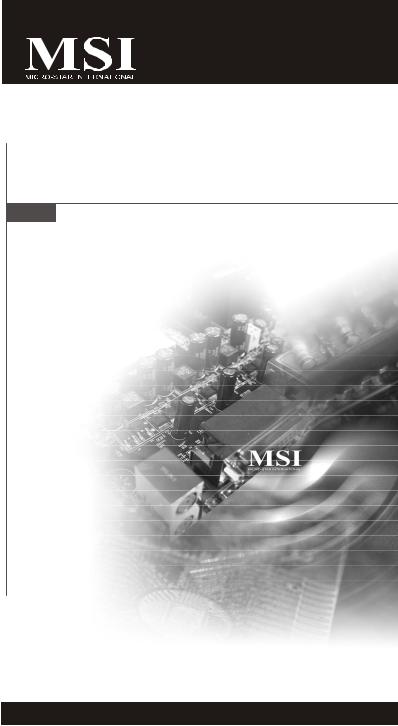
K9N4 SLI Series
MS-7325 (V1.X) Mainboard
G52-73251X1
i

Copyright Notice
The material in this document is the intellectual property of M ICRO-STAR INTERNATIONAL. We take every care in the preparation of this document, but no guarantee is given as to the correctness of its contents. Our products are under continual improvement and we reserve the right to make changes without notice.
Trademarks
All trademarks are the properties of their respective owners.
NVIDIA, the NVIDIA logo, DualNet, and nForce are registered trademarks or trademarks of NVIDIA Corporation in the United States and/or other countries.
AMD, Athlon™, Athlon™ XP, Thoroughbred™, and Duron™ are registered trademarks of AMD Corporation.
Intel® and Pentium® are registered trademarks of Intel Corporation.
PS/2 and OS®/2 are registered trademarks of International Business Machines Corporation.
Windows® 95/98/2000/NT/XP are registered trademarks of Microsoft Corporation. Netware® is a registered trademark of Novell, Inc.
Award® is a registered trademark of Phoenix Technologies Ltd. AMI® is a registered trademark of American Megatrends Inc.
Revision History
Revision |
Revision History |
Date |
V1.0 |
First release for PCB 1.X |
October 2006 |
Technical Support
If a problem arises with your system and no solution can be obtained from the user’s manual, please contact your place of purchase or local distributor. Alternatively, please try the following help resources for further guidance.
 Visit the MSI website for FAQ, technical guide, BIOS updates, driver updates, and other information: http://www.msi.com.tw/program/service/faq/ faq/esc_faq_list.php
Visit the MSI website for FAQ, technical guide, BIOS updates, driver updates, and other information: http://www.msi.com.tw/program/service/faq/ faq/esc_faq_list.php
 Contact our technical staff at: http://support.msi.com.tw/
Contact our technical staff at: http://support.msi.com.tw/
ii

Safety Instructions
1.Always read the safety instructions carefully.
2.Keep this User’s Manual for future reference.
3.Keep this equipment away from humidity.
4.Lay this equipment on a reliable flat surface before setting it up.
5.The openings on the enclosure are for air convection hence protects the equipment from overheating. DO NOT COVER THE OPENINGS.
6.Make sure the voltage of the power source and adjust properly 110/220V before connecting the equipment to the power inlet.
7.Place the power cord such a way that people can not step on it. Do not place anything over the power cord.
8.Always Unplug the Power Cord before inserting any add-on card or module.
9.All cautions and warnings on the equipment should be noted.
10.Never pour any liquid into the opening that could damage or cause electrical shock.
11.If any of the following situations arises, get the equipment checked by service personnel:
†The power cord or plug is damaged.
†Liquid has penetrated into the equipment.
†The equipment has been exposed to moisture.
†The equipment does not work well or you can not get it work according to User’s Manual.
†The equipment has dropped and damaged.
†The equipment has obvious sign of breakage.
12.DONOT LEAVETHIS EQUIPMENT INANENVIRONMENT UNCONDITIONED, STORAGE TEMPERATURE ABOVE 600 C (1400F), IT MAYDAMAGE THE EQUIPMENT.
CAUTION: Danger of explosion if battery is incorrectly replaced. Replace only with the same or equivalent type recommended by the manufacturer.
iii
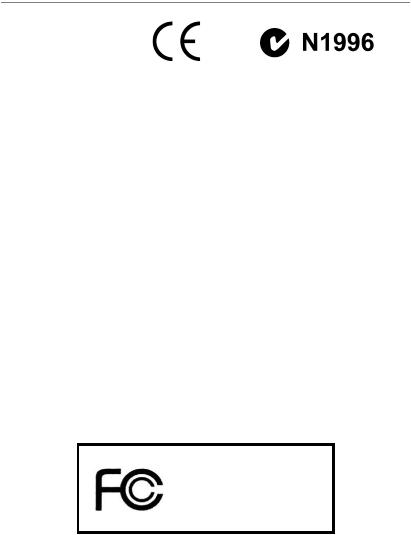
FCC-B Radio Frequency Interference Statement
This equipment has been tested and found to comply with the limits for a Class B digital device, pursuant to Part
15 of the FCC Rules. These limits are designed to provide reasonable protection against harmful interference in a residential installation. This equipment generates, uses and can radiate radio frequency energy and, if not installed and used in accordance with the instructions, may cause harmful interference to radio communications. However, there is no guarantee that interference will not occur in a particular installation. If this equipment does cause harmful interference to radio or television reception, which can be determined by turning the equipment off and on, the user is encouraged to try to correct the interference by one or more of the measures listed below.
†Reorient or relocate the receiving antenna.
†Increase the separation between the equipment and receiver.
†Connect the equipment into an outlet on a circuit different from that to which the receiver is connected.
†Consult the dealer or an experienced radio/television technician for help.
Notice 1
The changes or modifications not expressly approved by the party responsible for compliance could void the user’s authority to operate the equipment.
Notice 2
Shielded interface cables and A.C. power cord, if any, must be used in order to comply with the emission limits.
VOIR LANOTICE D’INSTALLATIONAVANT DE RACCORDER AU RESEAU.
Micro-Star International
MS-7325
This device complies with Part 15 of the FCC Rules. Operation is subject to the following two conditions:
(1)this device may not cause harmful interference, and
(2)this device must accept any interference received, including interference that may cause undesired operation.
iv

WEEE (Waste Electrical and Electronic Equipment) Statement
v

vi

vii
|
CONTENTS |
|
Copyright |
Notice .............................................................................................................. |
ii |
Trademarks ....................................................................................................................... |
ii |
|
Revision |
History .............................................................................................................. |
ii |
Technical |
Support ........................................................................................................... |
ii |
Safety Instructions ......................................................................................................... |
iii |
|
FCC-B Radio Frequency Interference Statement ........................................................ |
iv |
|
WEEE (Waste Electrical and Electronic Equipment) Statement .................................... |
v |
|
Chapter 1. Getting Started .................................................................................... |
1-1 |
|
Mainboard Specifications ................................................................................... |
1-2 |
|
Mainboard Layout ................................................................................................ |
1-4 |
|
Packing Checklist ................................................................................................. |
1-5 |
|
Chapter 2. Hardware Setep .................................................................................. |
2-1 |
|
Quick Components Guide .................................................................................... |
2-2 |
|
CPU (Central Processing Unit) ............................................................................ |
2-3 |
|
CPU Installation Procedures for Socket AM2 ............................................ |
2-4 |
|
Installing AMD Socket AM2 CPU Cooler Set ............................................... |
2-5 |
|
Memory................................................................................................................. |
2-6 |
|
Dual-Channel Memory Population Rules .................................................... |
2-6 |
|
Installing DDRII Modules ............................................................................... |
2-7 |
|
Power Supply ...................................................................................................... |
2-8 |
|
ATX 24-Pin Power Connector: JPWR1 ...................................................... |
2-8 |
|
ATX 12V Power Connector: JPW1/ PCIE_PW1 ......................................... |
2-8 |
|
Important Notification about Power Issue .................................................. |
2-9 |
|
Back Panel .......................................................................................................... |
2-10 |
|
Connectors ........................................................................................................ |
2-12 |
|
Floppy Disk Drive Connector: FDD1 .......................................................... |
2-12 |
|
ATA133 Hard Disk Connectors: IDE1/ IDE2 .............................................. |
2-12 |
|
Serial ATA Connectors: SATA1~SATA4 ................................................... |
2-13 |
|
Fan Power Connectors: CPUFAN1, SYSFAN1, NBFAN1 & SYSFAN2 .. |
2-14 |
|
Chassis Intrusion Switch Connector: JCI1 .............................................. |
2-14 |
|
Aux Line-In Connector: JCD1 ................................................................... |
2-14 |
|
Front Panel Audio Connector: JAUD1 ...................................................... |
2-15 |
|
IrDA Infrared Module Header: JIR1 ........................................................... |
2-15 |
|
Front USB Connectors: JUSB1, JUSB2 & JUSB3 ................................... |
2-16 |
|
SPDIF-Out Connector: JSPDO1 (Optional, for HDMI graphics card only) ..... |
||
2-16 |
|
|
Front Panel Connectors: JFP1/ JFP2 ....................................................... |
2-17 |
|
viii
D-Bracket™ 2 Connector: JDB1 ............................................................... |
2-18 |
Button ................................................................................................................. |
2-19 |
Clear CMOS Button : SW1......................................................................... |
2-19 |
Slots .................................................................................................................... |
2-20 |
PCI (Peripheral Component Interconnect) Express Slots ....................... |
2-20 |
NV SLI Technology .................................................................................... |
2-21 |
PCI (Peripheral Component Interconnect) Slots ...................................... |
2-23 |
PCI Interrupt Request Routing ................................................................... |
2-23 |
Chapter 3. BIOS Setup ............................................................................................ |
3-1 |
Entering Setup ..................................................................................................... |
3-2 |
Control Keys ................................................................................................ |
3-3 |
Getting Help .................................................................................................. |
3-3 |
General Help <F1> ....................................................................................... |
3-3 |
The Main Menu ..................................................................................................... |
3-4 |
Standard CMOS Features ................................................................................... |
3-6 |
Advanced BIOS Features ................................................................................... |
3-9 |
Advanced Chipset Features ............................................................................. |
3-11 |
Integrated Peripherals ....................................................................................... |
3-12 |
Power Management Setup ............................................................................... |
3-15 |
PNP/PCI Configurations ..................................................................................... |
3-18 |
H/W Monitor ........................................................................................................ |
3-20 |
Cell Menu ............................................................................................................ |
3-21 |
Load Optimized Defaults ................................................................................... |
3-27 |
BIOS Setting Password ..................................................................................... |
3-28 |
Appendix A. Realtek ALC850 Audio ................................................................... |
A-1 |
Installing the Audio Driver ................................................................................... |
A-2 |
Installation for Windows 2000/XP .............................................................. |
A-2 |
Software Configuration ...................................................................................... |
A-4 |
Sound Effect ................................................................................................ |
A-5 |
Speaker Configuration ................................................................................ |
A-7 |
3D Audio Demo ............................................................................................. |
A-9 |
General ....................................................................................................... |
A-10 |
SPDIF........................................................................................................... |
A-11 |
Hardware Setup ................................................................................................ |
A-12 |
Appendix B. Dual Core Center ............................................................................. |
B-1 |
Activating Dual Core Center ............................................................................... |
B-2 |
Main ...................................................................................................................... |
B-3 |
Introduction: ................................................................................................. |
B-3 |
ix
DOT (Dynamic OverClocking) ............................................................................. |
B-5 |
Clock ..................................................................................................................... |
B-6 |
Voltage ................................................................................................................. |
B-7 |
FAN Speed ........................................................................................................... |
B-8 |
Temperature ......................................................................................................... |
B-9 |
User Profile ........................................................................................................ |
B-10 |
Appendix C. nVidia RAID ........................................................................................ |
C-1 |
Introduct ion ......................................................................................................... |
C-2 |
System Requirement ................................................................................... |
C-2 |
RAID Arrays ................................................................................................. |
C-2 |
Summary of RAID Configurations ............................................................... |
C-2 |
RAID Configuration .............................................................................................. |
C-3 |
Basic Configuration Instructions ................................................................ |
C-3 |
Setting Up the NVRAID BIOS ....................................................................... |
C-3 |
Installing the RAID Driver (for bootable RAID Array) ................................ |
C-7 |
NVIDIA RAID Utility Installation ............................................................................. |
C-9 |
Installing the NVIDIA RAID Software Under Windows (for Non-bootable RAID |
|
Array) ........................................................................................................... |
C-9 |
Initializing and Using the Disk Array ......................................................... |
C-10 |
RAID Drives Management .................................................................................. |
C-12 |
Setting Up a Spare RAID Disk ................................................................... |
C-13 |
Hot Plug Array ............................................................................................ |
C-18 |
Initializing a RAID Array ............................................................................. |
C-19 |
Rebuilding a RAID Array ............................................................................ |
C-22 |
Synchronizing a RAID Array ..................................................................... |
C-25 |
Appendix D. nVidia System Driver ..................................................................... |
D-1 |
NVIDIA System Driver Installation ....................................................................... |
D-2 |
nVidia System Driver ........................................................................................... |
D-2 |
nVidia Utility Installaion ........................................................................................ |
D-5 |
x
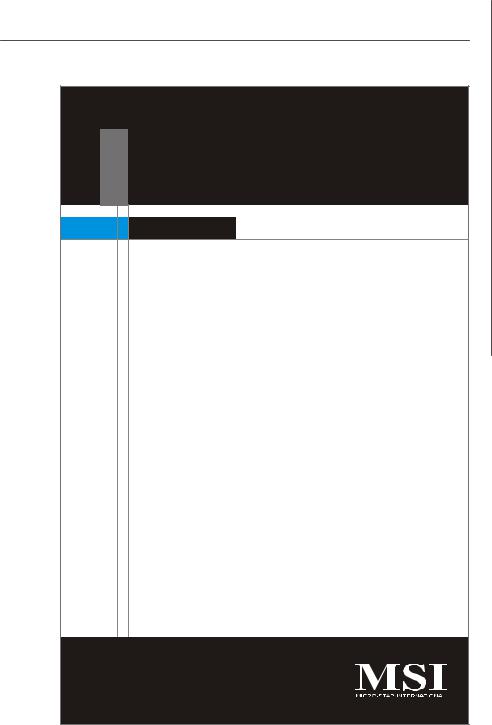
Getting Started
Chapter 1
Getting Started
Thank you for choosing the K9N4 SLI Series (MS-7325 v1.X) ATX mainboard. The K9N4 SLI Series mainboards are based on nVidia® nForce500 SLI chipsets for optimal system efficiency. Designed to fit the advanced
AM D® Athlon 64 X2/ Athlon 64 & Sempron processor, the K9N4 SLI Series deliver a high performance and professional desktop platform solution.
1-1
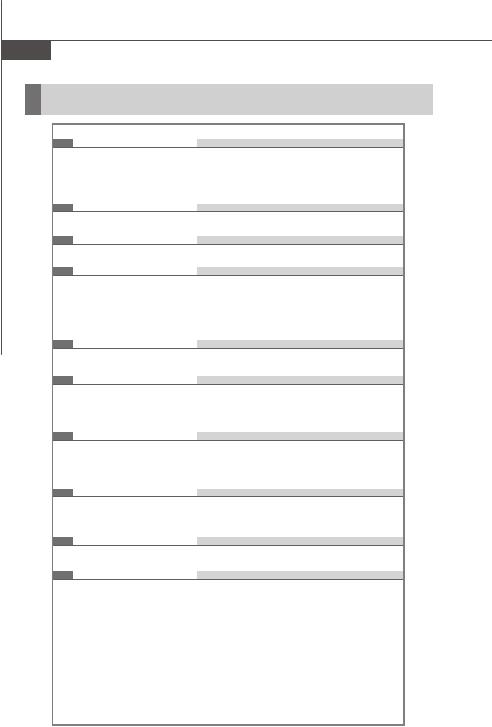
MS-7325 Mainboard
Mainboard Specifications
Processor Support
- AMD® Athlon 64/ X2 and Sempron in the socket AM2 package
(For the latest information about CPU, please visit http://www.msi. com.tw/program/products/mainboard/mbd/pro_mbd_cpu_support. php)
Supported FSB
- HyperTransport supporting speed up to 1 GHz (2000MT/s)
Chipset
- nVidia® nForce500 SLI chipset
Memory Support
-DDRII 533/667/800 SDRAM (8GB Max)
-4 DDRII DIMMs (240pin/ non-ECC)
(For more information on compatible components, please visit http:/ / w w w . m s i . c o m . t w / p r o g r a m / p r o d u c t s / m a i n b o a r d / m b d / pro_mbd_trp_list.php)
LAN
- Supports Giga LAN 10/100/1000 Fast Ethernet by Vitesse VSC8601
Audio
-Controlled by Realtek ALC850
-Supports 7.1 channels audio out
-Compliant with AC’97 Rev 2.3 Spec
IDE
-2 IDE ports
-Supports Ultra DMA 66/100/133 mode
-Supports PIO, Bus Master operation mode
SATA
-4 SATA II ports
-Supports storage and data transfers at up to 300 MB/s
RAID
- SATA1~4 supports RAID 0/ 1/ 0+1/ 5 or JBOD mode
Floppy
-1 floppy port
-Supports 1 FDD with 360K, 720K, 1.2M, 1.44M and 2.88Mbytes
1-2

Getting Started
 Connectors
Connectors
 Back panel
Back panel
-1 PS/2 mouse port
-1 PS/2 keyboard port.
-1 Serial port
-1 Parallel port supporting SPP/EPP/ECP mode
-4 USB 2.0 Ports.
-1 LAN jack
-6 audio jacks
 On-Board Pinheaders
On-Board Pinheaders
-1 D-Bracket 2 pinheader
-1 IrDA pinheader
-3 USB 2.0 pinheaders
-1 SPDIF-Out pinheader
Slots
-2 PCI Express x 16 slots, compatible with PCI Express x 8 speed (Support SLI technology)
-2 PCI Express x 1 slots
-2 PCI slots, support 3.3V/ 5V PCI bus Interface
Form Factor
- ATX (30.5 cm X 24.5 cm)
Mounting
- 9 mounting holes
1-3
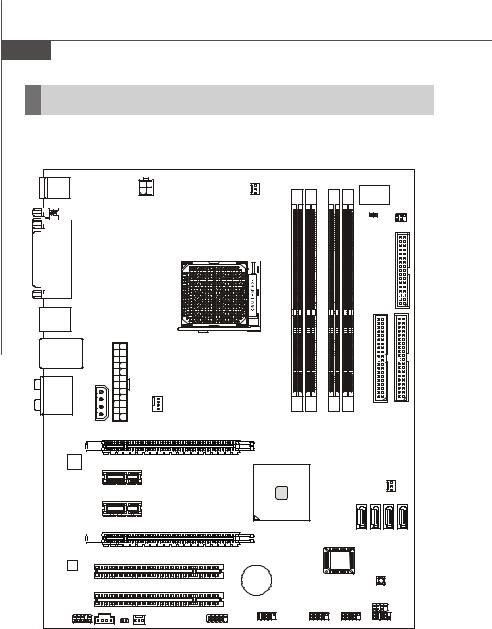
MS-7325 Mainboard |
|
|
|
|
|
|
|
|
|||
Mainboard Layout |
|
|
|
|
|
|
|
|
|||
Top : mouse |
|
|
|
|
SYSFAN1 |
|
|
|
|
|
|
Bottom: |
|
|
|
|
|
|
Winbond |
|
|
||
keyboard |
|
|
|
|
|
|
|
|
|||
|
|
JPW1 |
|
|
|
|
I/O |
|
|
||
|
|
|
|
|
|
|
|
JIR1 |
|||
|
|
|
|
|
|
|
|
|
|||
|
|
|
|
|
|
|
|
|
|
||
|
|
|
|
|
|
|
|
|
JCI1 |
|
|
Top : |
|
|
|
|
|
|
|
|
|
|
|
Parallel Port |
|
|
|
|
|
|
|
|
|
|
|
Bottom: |
|
|
|
|
|
|
|
|
|
|
|
Com Port |
|
|
|
|
|
|
|
|
|
|
|
|
|
|
|
|
|
|
|
|
|
FDD1 |
|
USB ports |
|
|
|
|
|
|
|
|
|
|
|
Top: LAN Jack |
|
|
|
|
|
|
|
|
|
|
|
Bottom: USB ports |
PCIE PW1 |
JPWR1 |
|
|
|
|
|
|
|
|
|
T:Line-In |
CPUFAN1 |
|
|
|
|
|
|
|
|
||
M:Line-Out |
|
|
|
|
|
|
|
|
|||
B:Mic |
|
|
|
|
|
|
|
|
|||
T:RS-Out |
|
|
|
|
|
|
|
|
|
|
IDE1 |
M:CS-Out |
|
|
|
|
|
|
|
|
IDE2 |
|
|
B:SS-Out |
|
|
|
|
DIMM3 |
DIMM4 |
DIMM1 |
DIMM2 |
|
||
|
PCI_E1 |
|
|
|
|||||||
|
|
|
|
|
|
|
|
|
|
||
VSC8601 |
PCI_E2 |
|
|
|
|
|
|
|
|
|
|
|
|
|
Nvidia |
|
|
|
|
|
|
||
|
|
|
|
|
|
|
|
NBFAN1 |
|||
|
|
|
|
|
nForce500 SLI |
|
|
|
|||
|
|
|
|
|
|
|
|
|
|
|
|
|
PCI_E3 |
|
|
|
|
|
|
|
|
|
|
|
PCI_E4 |
|
|
|
|
|
SATA3 |
SATA4 |
SATA1 |
SATA2 |
|
|
|
|
|
|
|
|
|
||||
ALC850 |
|
PCI1 |
|
|
|
|
BIOS |
|
|
|
|
|
|
|
|
|
|
|
|
SW1 |
|
|
|
|
|
|
|
|
BATT |
|
|
|
|
|
|
|
|
|
|
|
|
|
|
|
|
|
|
|
|
PCI2 |
|
|
+ |
|
|
|
|
|
|
|
|
|
|
|
|
|
|
|
|
|
|
|
|
|
|
|
|
|
|
|
JFP2 |
|
|
JAUD1 |
|
JSPDO1 |
|
|
|
|
|
|
|
|
|
|
JCD1 |
|
SYSFAN2 |
JDB1 |
JUSB2 |
JUSB1 |
|
JUSB3 |
JFP1 |
|
|
|
|
|
|
|
|
||||||
K9N4 SLI Series (MS-7325 v1.X) ATX Mainboard
1-4
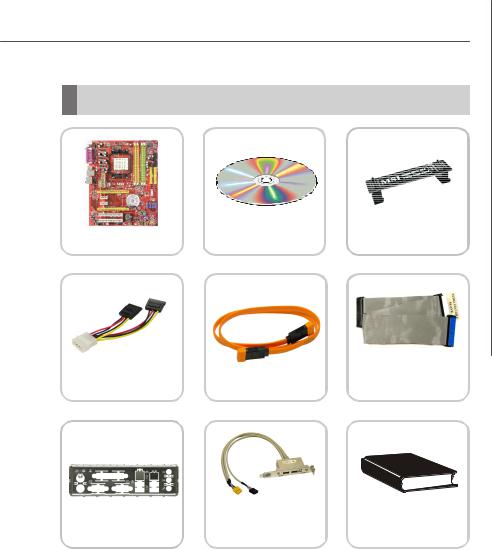
Getting Started
Packing Checklist
MSI motherboard |
MSI Driver/Utility CD |
SLI Video Link Card |
|
|
|
|
Standard Cable for |
Power Cable |
SATA Cable |
IDE Devices (Optional) |
|
|
|
D-Bracket 2 |
|
Back IO Shield |
(Optional) |
User’s Guide |
* The pictures are for reference only and may vary from the packing contents of the product you purchased.
1-5
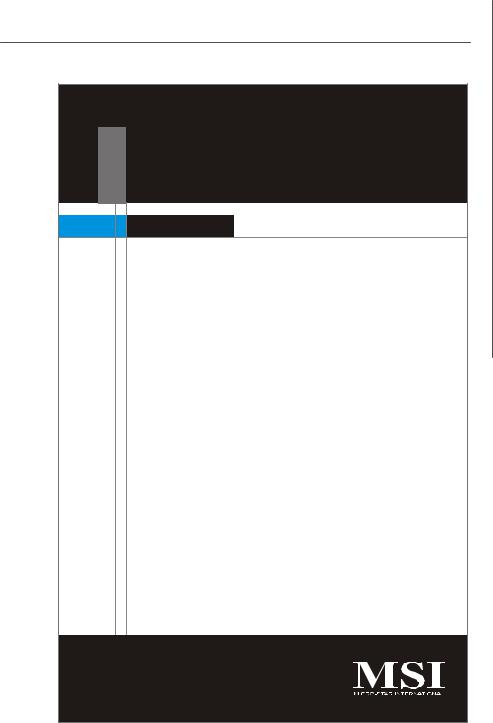
Hardware Setup
Chapter 2
Hardware Setup
This chapter provides you with the information about hardware setup procedures. While doing the installation, be careful in holding the components and follow the installation procedures. For some components, if you install in the wrong orientation, the components will not work properly.
Use a grounded wrist strap before handling computer components. Static elec tric ity may damage the components.
2-1

MS-7325 Mainboard
Quick Components Guide
CPUFAN1, |
CPU, p.2-3 |
DDRII DIMMs, p.2-6 |
||
p.2-14 |
|
|
|
|
|
|
|
|
|
|
JPW1, |
|
SYSFAN1, |
|
JPWR1, |
|
p.2-14 |
JCI1, p.2-14 |
|
p.2-8 |
|
|||
p.2-8 |
|
|
||
|
|
|
||
|
|
|
|
|
|
|
|
|
JIR1, p.2-15 |
Back Panel |
|
|
|
FDD1, p.2-12 |
|
|
|
|
|
I/O, p.2-10 |
|
|
|
|
|
|
|
|
IDE1/2, p.2-12 |
PCIE_PW1, |
|
|
|
|
p.2-8 |
|
|
|
|
PCI Express |
|
|
|
NBFAN1, p.2-14 |
slots, p.2-20 |
|
|
|
SATA1~4, |
|
|
|
|
|
|
|
|
|
p.2-13 |
PCI Slots, |
|
|
|
SW1, p.2-19 |
p.2-23 |
|
|
|
|
|
|
|
|
|
JAUD1, |
|
|
|
JFP2, p.2-17 |
|
|
|
JFP1, p.2-17 |
|
p.2-15 |
|
|
|
|
JCD1, p.2-14 |
SYSFAN2, |
|
JUSB1~3, p.2-16 |
|
p.2-14 |
|
|
||
|
|
|
||
|
|
|
|
|
|
|
|
JDB1, p.2-18 |
|
JSPDO1, |
|
|
|
|
p.2-16 |
|
|
|
|
2-2 |
|
|
|
|

Hardware Setup
CPU (Central Processing Unit)
The mainboard supports AMD® Athlon64/ X2 & Sempron processors. The mainboard uses a CPU socket called Socket AM2 for easy CPU installation. W hen you are installing the CPU, make sure the CPU has a heat sink and a cooling fan attached on the top to prevent overheating. If you do not have the heat sink and cooling fan, contact your dealer to purchase and install them before turning on the computer.
For the latest information about CPU, please visit http://www.msi.com.tw/program/ products/mainboard/mbd/pro_mbd_cpu_support.php
Important
1.Overheating will seriously damage the CPU and system. Always make sure the cooling fan can work properly to protect the CPU from overheating.
2.Make sure that you apply an even layer of heat sink paste (or thermal tape) between the CPU and the heatsink to enhance heat dissipation.
3.While replacing the CPU, always turn off the ATX power supply or unplug the power supply’s power cord from the grounded outlet first to ensure the safety of CPU.
2-3
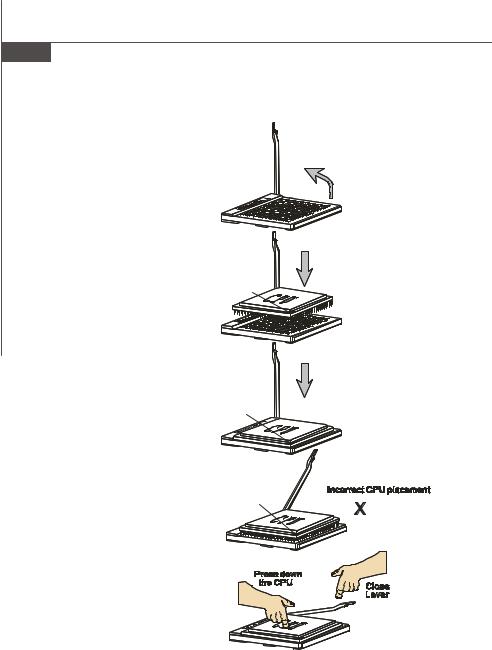
MS-7325 Mainboard
CPU Installation Procedures for Socket AM2
1.Please turn off the power and unplug the power cord before installing the CPU.
2.Pull the lever sideways away from the socket. Make sure to raise the lever up to a 90-de- gree angle.
3.Look for the gold arrow of the CPU. The gold arrow should point as shown in the picture. The CPU can only fit in the correct orientation.
4.If the CPU is correctly installed, the pins should be completely embedded into the socket and can not be seen. Please note that any violation of the correct installation proc edures may cause permanent damages to your mainboard.
5.Press the CPU down firmly into the socket and close the lever. As the CPU is likely to move while the lever is being closed, always close the lever with your fingers pressing tightly on top of the CPU to make sure the CPU is properly and completely embedded into the socket.
|
Open Lever |
|
Sliding |
90 degree |
|
Plate |
||
|
Gold arrow
Correct CPU placement
Gold arrow |
O |
|
Gold arrow
2-4
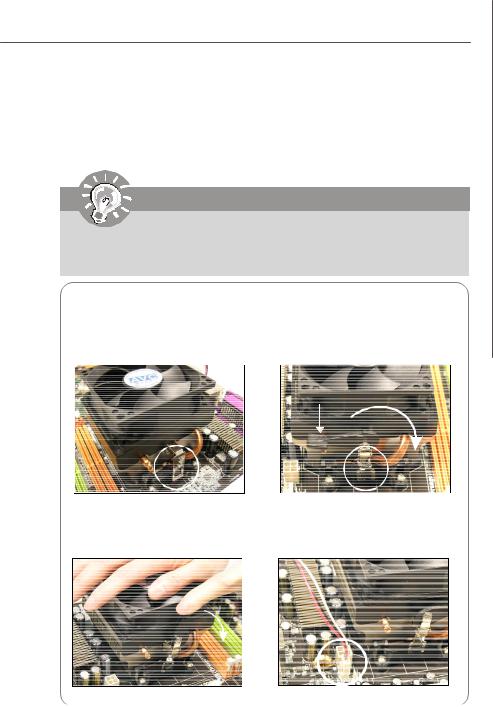
Hardware Setup
Installing AMD Socket AM2 CPU Cooler Set
W hen you are installing the CPU, make sure the CPU has a heat sink and a cooling fan attached on the top to prevent overheating. If you do not have the heat sink and cooling fan, contact your dealer to purchase and install them before turning on the computer.
Important
Mainboard photos shown in this section are for demonstration of the cooler installation for Socket AM2 CPUs only. The appearance of your mainboard may vary depending on the model you purchase.
1.Position the cooling set onto the retention mechanism.
Hook one end of the clip to hook first.
2.Then press down the other end of the clip to fasten the cooling set on the top of the retention mechanism. Locate the Fix Lever and lift up it .
Fixed Lever
3. Fasten down the lever.
4.Attach the CPU Fan cable to the CPU fan connector on the mainboard.
2-5

MS-7325 Mainboard
Memory
The mainboard provides four 240-pin non-ECC DDRII DIMMs and supports up to 8GB system memory.
For more information on compatible components, please visit http://www.msi.com.tw/ program/products/mainboard/mbd/pro_mbd_trp_list.php
DDRII
240-pin, 1.8V
56x2=112 pin |
64x2=128 pin |
Dual-Channel Memory Population Rules
1 |
DIMM3 |
|
|
|
DIMM4 |
|
DIMM1 |
|
DIMM2 |
2 |
DIMM3 |
|
DIMM4 |
|
DIMM1 |
|
DIMM2 |
3 |
DIMM3 |
|
DIMM4 |
 DIMM1
DIMM1
 DIMM2
DIMM2
2-6
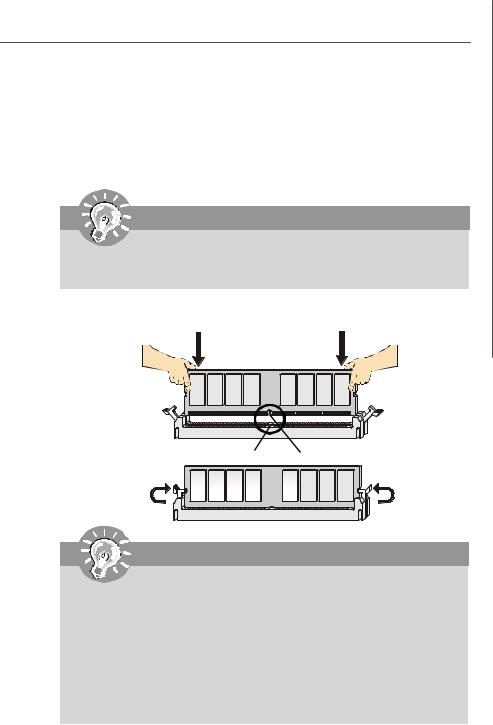
Hardware Setup
Installing DDRII Modules
1.The memory module has only one notch on the center and will only fit in the right orientation.
2.Insert the memory module vertically into the DIMM slot. Then push it in until the golden finger on the memory module is deeply inserted in the DIMM slot.
Important
You can barely see the golden finger if the module is properly inserted in the DIMM slot.
3. The plastic clip at each side of the DIMM slot will automatically close.
Volt Notch
Important
-DDRII modules are not interchangeable with DDR and the DDRII standard is not backwards compatible. You should always install DDRII memory modules in the DDRII DIMMs and DDR memory modules in the DDR DIMMs.
-In dual-channel mode, make sure that you install memory modules of the
same type and density in different channel DDR DIMMs.
-To enable successful system boot-up, always insert the memory modules into the DIMM1 first.
-Due to the chipset resource deployment, the system density will only be detected up to 7+GB (not full 8GB) when each DIMM is installed with a 2GB memory module.
2-7
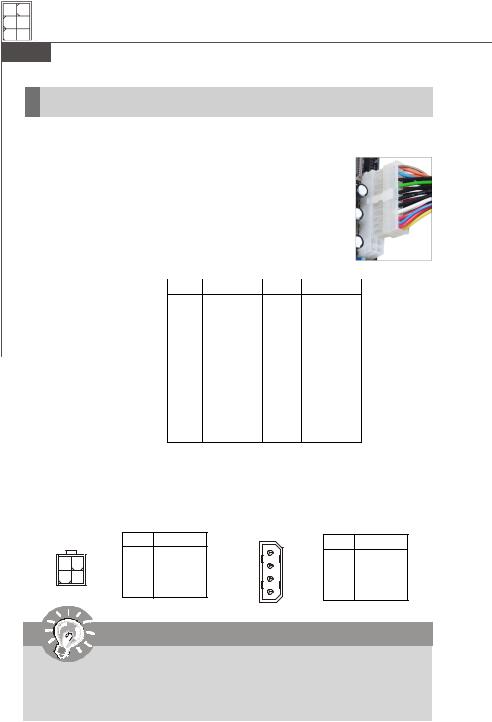
MS-7325 Mainboard
Power Supply
ATX 24-Pin Power Connector: JPWR1
This connector allows you to connect an ATX 24-pin power supply. To connect the ATX 24-pin power supply, make sure the plug of the power supply is inserted in the proper orientation and the pins are aligned. Then push down the power supply firmly into the connector.
You may use the 20-pin ATX power supply as you like. If you’d like to use the 20-pin ATX power supply, please plug your power supply along with pin 1 & pin 13 (refer to the image at the right hand). There is also a foolproof design on pin 11, 12, 23 & 24 to avoid wrong installation.
|
|
|
Pin Definition |
|
||
12 |
24 |
PIN |
SIGNAL |
PIN |
SIGNAL |
|
|
|
1 |
+3.3V |
13 |
+3.3V |
|
|
|
2 |
+3.3V |
14 |
-12V |
|
JPWR1 |
|
3 |
GND |
15 |
GND |
|
|
4 |
+5V |
16 |
PS-ON# |
||
|
|
5 |
GND |
17 |
GND |
|
|
|
6 |
+5V |
18 |
GND |
|
|
|
7 |
GND |
19 |
GND |
|
|
|
8 |
PWROK |
20 |
Res |
|
|
|
9 |
5VSB |
21 |
+5V |
|
|
|
10 |
+12V |
22 |
+5V |
|
1 |
13 |
11 |
+12V |
23 |
+5V |
|
12 |
+3.3V |
24 |
GND |
|||
|
|
|||||
 pin 13
pin 13
 pin 12
pin 12
ATX 12V Power Connector: JPW1/ PCIE_PW1
This 12V power connector JPW1 is used to provide power to the CPU. This 12V power connector PCIE_PW 1 is used to provide power to stable the operation of graphics card.
JPW1 |
JPW1 Pin Definition |
PCIE_PW1 |
PCIE_PW1 Pin Definition |
||||
PIN |
SIGNAL |
PIN |
SIGNAL |
||||
3 |
4 |
1 |
|||||
1 |
GND |
|
|
||||
|
|
1 |
5V |
||||
|
|
|
|||||
|
|
2 |
GND |
|
2 |
GND |
|
1 |
2 |
3 |
12V |
|
3 |
GND |
|
4 |
12V |
|
4 |
12V |
|||
Important
1.Maker sure that all the connectors are connected to proper ATX power supplies to ensure stable operation of the mainboard.
2.Power supply of 450 watts (and above) is highly recommended for system stability.
2-8
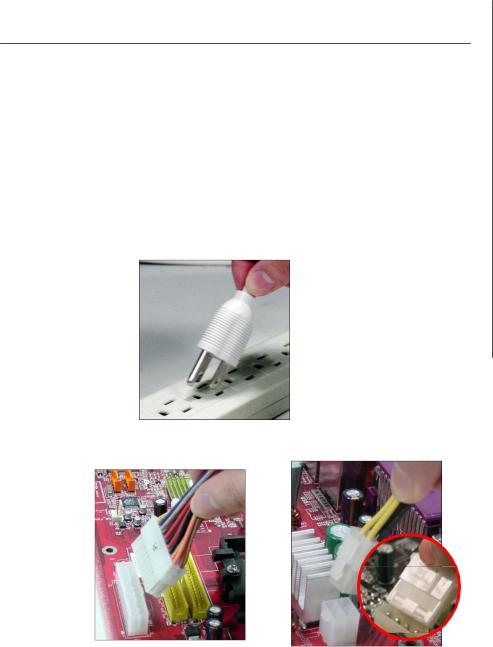
Hardware Setup
Important Notification about Power Issue
NForce chipset is very sensitive to ESD (Electrostatic Discharge), therefore this issue mostly happens while the users intensively swap memory modules under S5 (power-off) states, and the power code is plugged while installing modules. Due to several pins are very sensitive to ESD, so this kind of memory-replacement actions might cause system chipset unable to boot. Please follow the following solution to avoid this situation.
Unplug the AC power cable (shown in figure 1) or unplug the JPWR1/ PCIE_PW1 & JPW1 power connectors (shown in figure 2 & figure 3) before the 1st installation or during system upgrade procedure.
Figure 1:
Unplug the AC power cable
Figure 2: |
Figure 3: |
|
Unplug the JPWR1 power conn. |
||
Unplug the JPW1/ PCIE_PW1 |
||
|
||
|
power connectors |
2-9
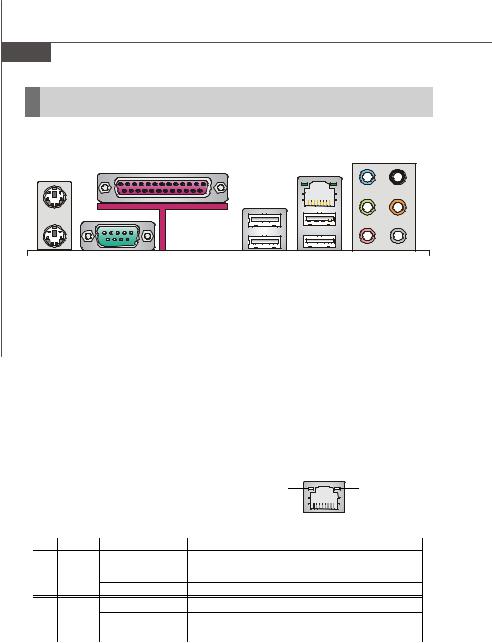
MS-7325 Mainboard
Back Panel
|
Parallel Port |
L-In RS-Out |
|
M ouse |
LAN |
||
|
|
|
|
|
Keyboard Serial Port |
USB Ports |
L-Out CS-Out |
|
|
|
|
Mic SS-Out |
 Mouse/Keyboard Connector
Mouse/Keyboard Connector
The standard PS/2® mouse/keyboard DIN connector is for a PS/2® mouse/keyboard.
 Parallel Port Connector
Parallel Port Connector
A parallel port is a standard printer port that supports Enhanced Parallel Port (EPP) and Extended Capabilities Parallel Port (ECP) mode.
 Serial Port Connector
Serial Port Connector
The serial port is a 16550A high speed communications port that sends/ receives 16 bytes FIFOs. You can attach a serial mouse or other serial devices directly to the connector.
 LAN (RJ-45) Jack
LAN (RJ-45) Jack
The standard RJ-45 jack is for connection to single Local Area Network (LAN). You can connect a network cable to it.
ActivityIndicator |
LinkIndicator |
LED |
Color |
LED State |
condition |
|
|
Off |
LAN link is not established. |
Left |
Orange |
On (steady state) |
LAN link is established. |
|
|
On (brighter & pulsing) The computeris communicating with another computer on the LAN. |
|
|
Green |
Off |
10 Mbit/sec data rate is selected. |
Right |
|
On |
100 Mbit/sec data rate is selected. |
|
Orange |
On |
1000 Mbit/sec data rate is selected. |
2-10

Hardware Setup
 USB Connectors
USB Connectors
The OHCI (Open Host Controller Interface) Universal Serial Bus root is for attaching USB devices such as keyboard, mouse, or other USB-compatible devices.
 Audio Port Connectors
Audio Port Connectors
These audio connectors are used for audio devices. You can differentiate the color of the audio jacks for different audio sound effects.
Blue audio jack - Line In, is used for external CD player, tapeplayer or other audio devices.
Green audio jack - Line Out, is a connector for speakers or headphones.
Pink audio jack - Mic In, is a connector for microphones.
Black audio jack - Rear-Surround Out in 4/ 5.1/ 7.1 channel mode.
Orange audio jack - Center/ Subwoofer Out in 5.1/ 7.1 channel mode. Gray audio jack - Side-Surround Out in 7.1 channel mode.
2-11
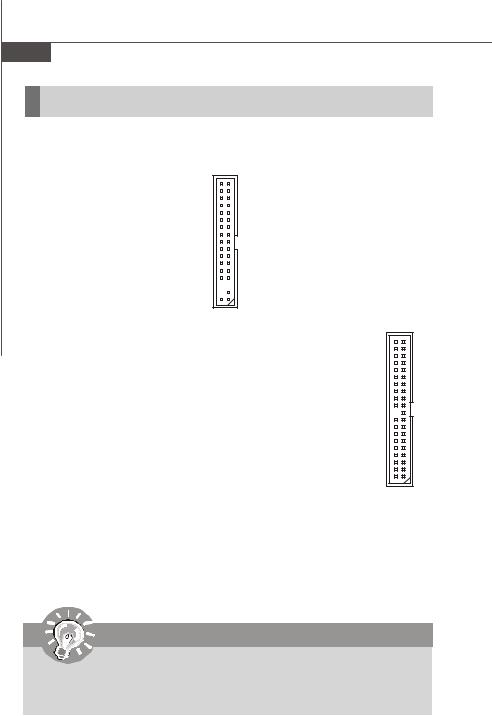
MS-7325 Mainboard
Connectors
Floppy Disk Drive Connector: FDD1
This standard FDD connector supports 360K, 720K, 1.2M, 1.44M and 2.88M floppy disk types.
FDD1
ATA133 Hard Disk Connectors: IDE1/ IDE2
The mainboard has a 32-bit Enhanced PCI IDE and Ultra DMA 66/100/133 controller that provides PIO mode 0~4, Bus Master, and Ultra DMA 66/ 100/133 function. You can connect hard disk drives, CD-ROM and other IDE devices.
The Ultra ATA133 interface boosts data transfer rates between the computer and the hard drive up to 133 megabytes (MB) per second. The new interface is one-third faster than earlier record-breaking Ultra ATA/ 100 technology and is backwards compatible with the existing Ultra ATA interface.
IDE1 (Primary IDE Connector)
The first hard drive should always be connected to IDE1. IDE1 can connect a Master and a Slave drive. You must configure the second hard drive to Slave mode by setting the jumper accordingly.
IDE2 (Secondary IDE Connector)
IDE2 can also connect a Master and a Slave drive.
Important
If you install two hard disks on IDE cable, you must configure the second drive to Slave mode by setting its jumper. Refer to the hard disk documentation supplied by hard disk vendors for jumper setting instructions.
2-12
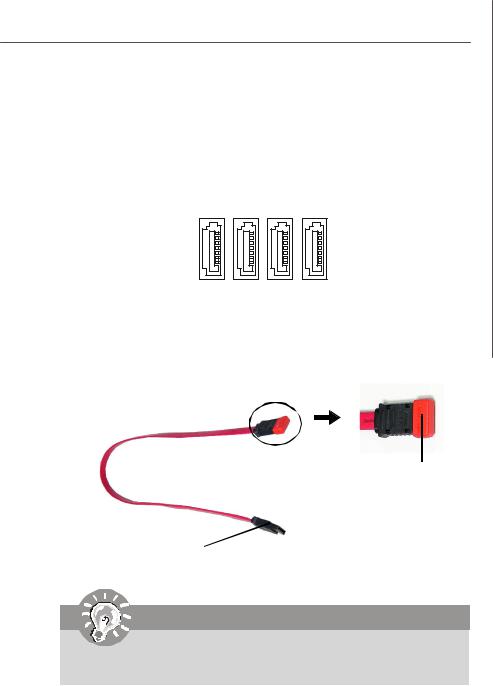
Hardware Setup
Serial ATA Connectors: SATA1~SATA4
SATA1~SATA4 are high-speed SATAII interface ports. Each supports data rates of 300 MB/s and is fully compliant with Serial ATA specifications. Each Serial ATA connector can connect to 1 hard disk device.
SATA3 SATA4 SATA1 SATA2
Serial ATA cable
Take out the dust cover and connect to the hard disk devices
Connect to SATA connector
Important
Please do not fold the Serial ATA cable into 90-degree angle. Otherwise, data loss may occur during transmission.
2-13
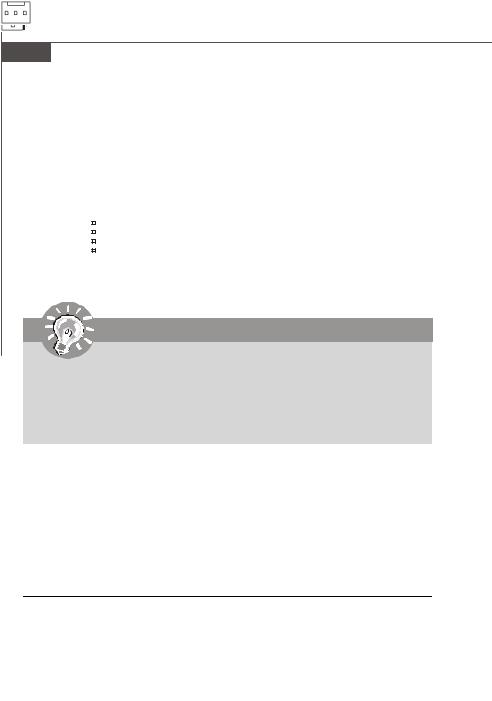
MS-7325 Mainboard
Fan Power Connectors: CPUFAN1, SYSFAN1, NBFAN1 & SYSFAN2
The fan power connectors support system cooling fan with +12V. When connecting the wire to the connectors, always take note that the red wire is the positive and should be connected to the +12V, the black wire is Ground and should be connected to GND. If the mainboard has a System Hardware Monitor chipset on-board, you must use a specially designed fan with speed sensor to take advantage of the CPU fan control.
|
|
|
GND |
GND |
|
|
|
+12V |
|
|
|
|
SENSOR |
+12V |
|
|
|
||
|
|
|
Control |
SENSOR |
CPUFAN1 |
SYSFAN1 |
|||
NC +12V GND
SYSFAN2
GND +12V SENSOR
NBFAN1
Important
1.Please refer to the recommended CPU fans at AMD® official website or consult the vendors for proper CPU cooling fan.
2.Always consult the vendors for proper CPU cooling fan.
3.Fan/heatsink with 3 or 4 pins are both available for CPUFAN1.
4.CPUFAN1 supports fan control. You can setup it in H/W Monitor of BIOS Setup.
Chassis Intrusion Switch Connector: JCI1
This connector connects to a 2-pin chassis switch. If the chassis is opened, the switch will be short. The system will record this status and show a warning message on the screen. To clear the warning, you must enter the BIOS utility and clear the record.
IN C
RTNG
UD
2 1
1
JCI1
Aux Line-In Connector: JCD1
The connector is for TV/ DVD add-on card with Line-in connector.
JCD1
R


 L
L
GND
2-14
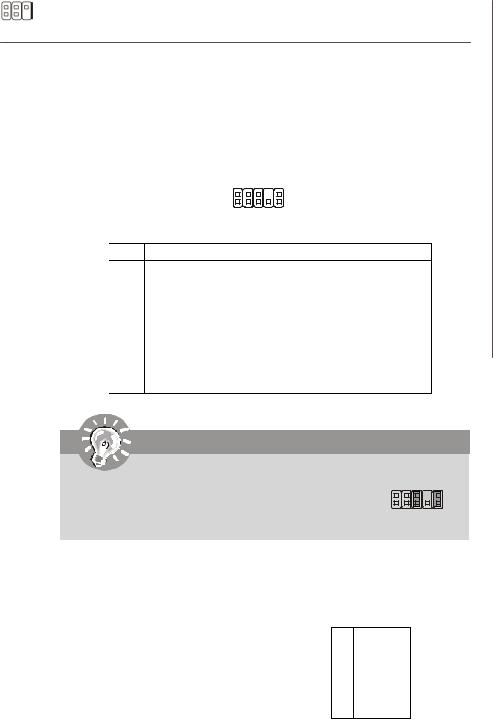
Hardware Setup
Front Panel Audio Connector: JAUD1
The JAUD1 front panel audio connector allows you to connect the front panel audio and is compliant with Intel® Front Panel I/O Connectivity Design Guide.
|
|
JAUD1 |
|
2 |
10 |
|
1 |
9 |
|
Pin Definition |
|
PIN |
SIGNAL |
DESCRIPTION |
1AUD_MIC
2AUD_GND
3AUD_MIC_BIAS
4AUD_VCC
5AUD_FPOUT_R
6AUD_RET_R
7HP_ON
8KEY
9AUD_FPOUT_L
10AUD_RET_L
Front panel microphone input signal Ground used by analog audio circuits Microphonepower
Filtered +5V used by analog audio circuits Right channel audio signal to front panel
Right channel audio signal return from front panel Reserved for future use to control headphone amplifier No pin
Left channel audio signal to front panel
Left channel audio signal return from front panel
Important
If you don’t want to connect to the front audio header, pins 5 & 6, 9 & 10 have to be jumpered in order to have signal output directed to the rear audio ports. Otherwise, the Line-Out connector on the back panel will not function.
6 10
5 9
IrDA Infrared Module Header: JIR1
The connector allows you to connect to IrDA Infrared module. You must configure the setting through the BIOS setup to use the IR function. JIR1 is compliant with Intel® Front Panel I/O Connectivity Design Guide.
|
|
Pin |
Definition |
|
|
|
Pin |
Signal |
|
5 |
1 |
1 |
NC |
|
2 |
NC |
|||
6 |
2 |
|||
JIR1 |
|
3 |
VCC5 |
|
|
4 |
GND |
||
|
|
5 |
IRTX |
|
|
|
6 |
IRRX |
2-15
